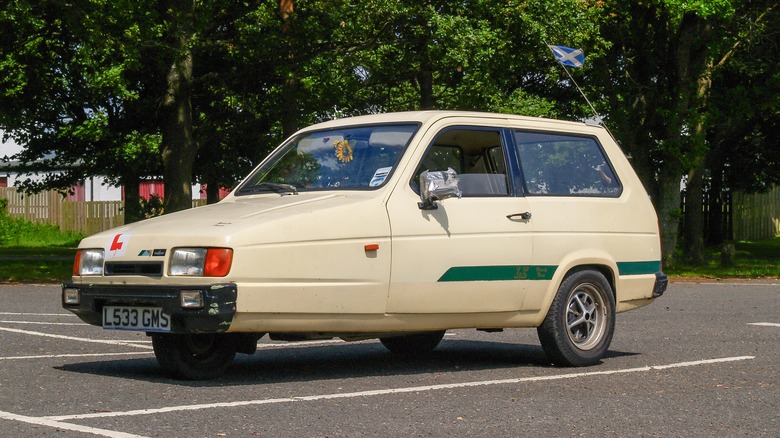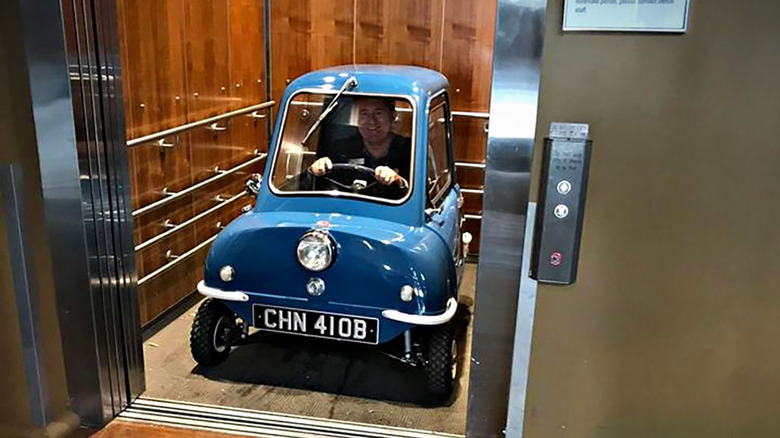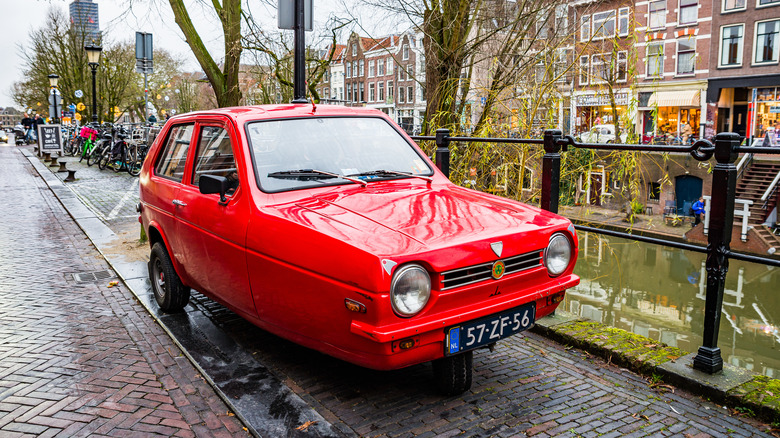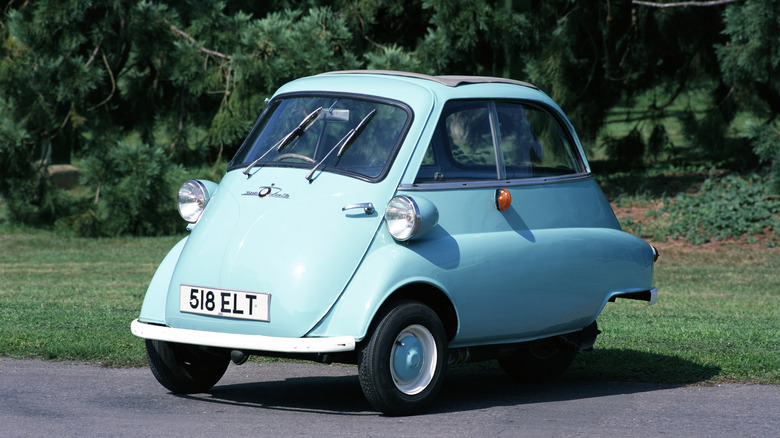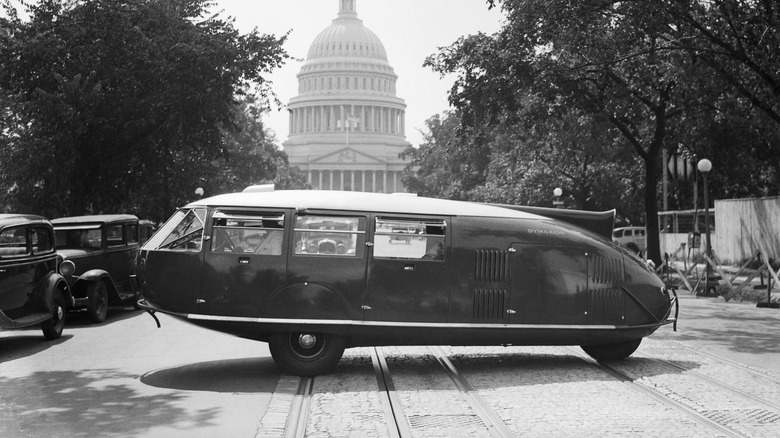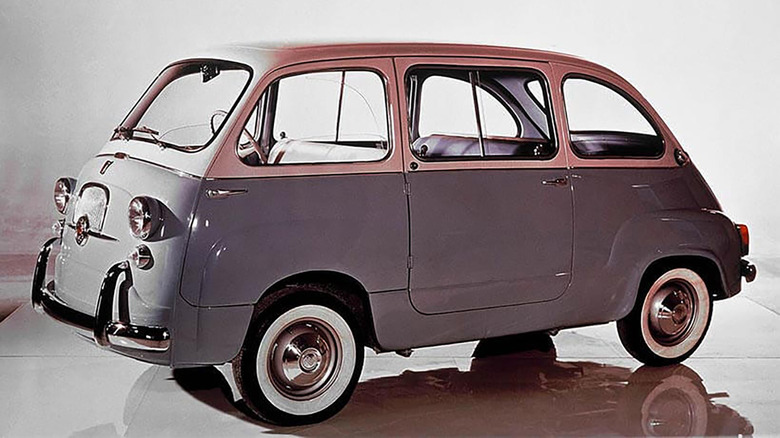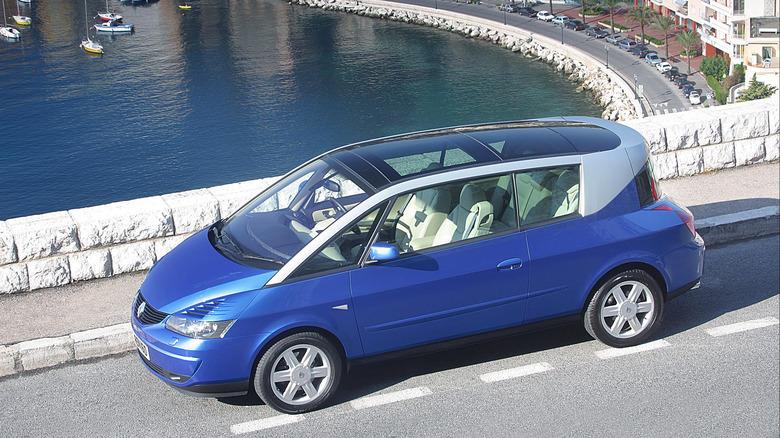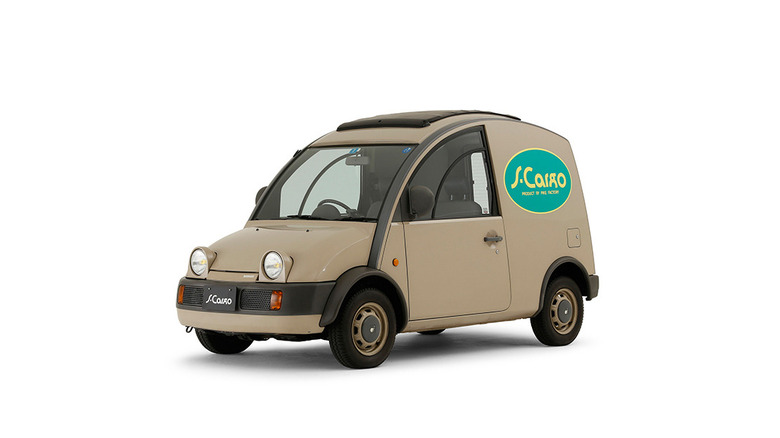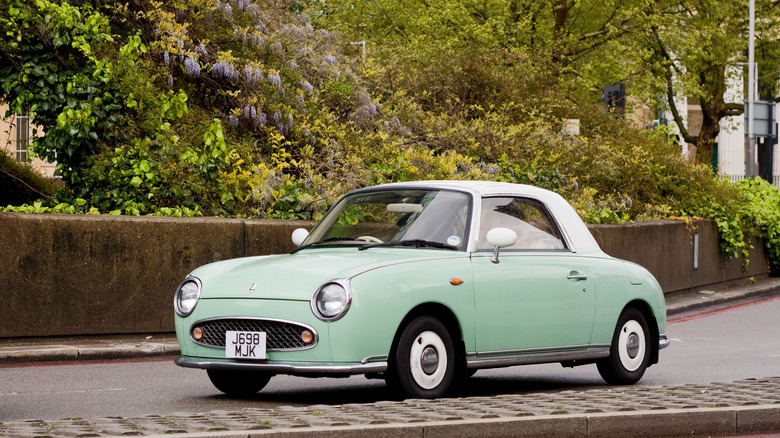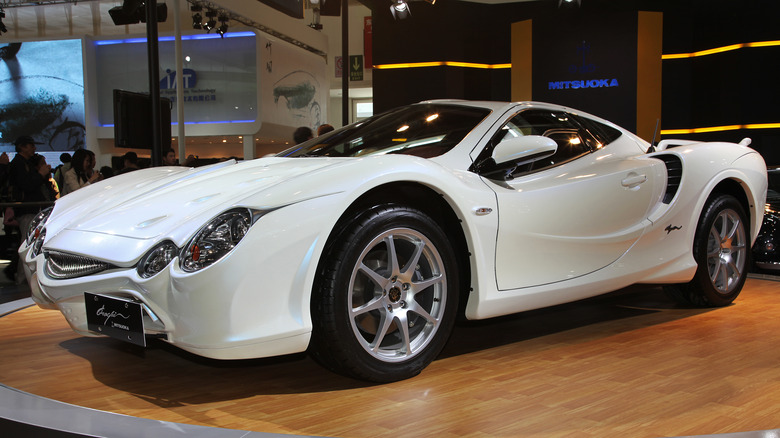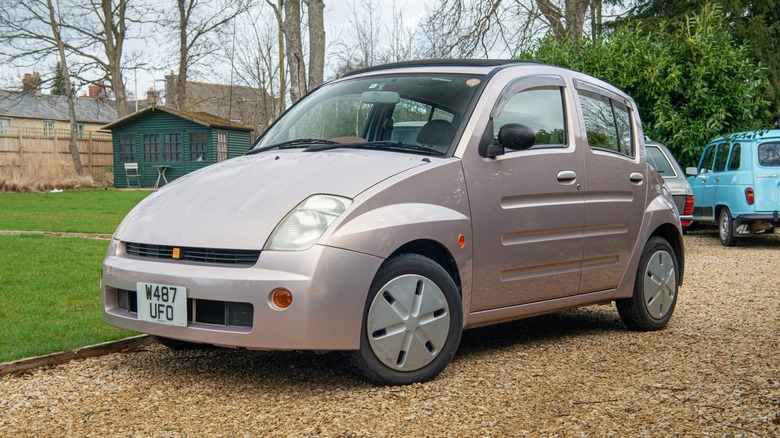10 Of The Weirdest Cars Ever Made
Have you ever gone car-gazing? You know, just walking around and looking at cars. It's something enthusiasts have a habit of doing because automobiles are simply amazing. However, today cars are becoming ever more monotonous. We wouldn't say boring — some still look amazing, but they all seem cut from the same cloth. And what's with all those monotone colors? Let's freshen things up a bit — brighter, flashier colors hold up their value better, anyway!
The world's strangest cars are anything but monotonous. In fact, they will easily steal your attention in a parking, even one filled with Ferraris and Lamborghinis. Some for good reasons, because weird can be interesting, and others for less good reasons. Regardless, knowing how these quirky car creations came to fruition may tickle your interest. Some might make you ask, "But why?" or "What were they thinking?", but there was no doubt some bravery involved in developing and designing these cars. And crazy ideas, of course!
Without further ado, let's have a look at some of the wildest creations of the automotive history.
Peel P50 (1962 to 1965, 2011 to Present)
Wheeled office chairs are quite the invention, letting you move inside your office without ever standing up. But what if you could have a motorized office that drives to work and into your company's offices? Enter the Peel P50 three-wheeler: the smallest car ever made! At only 54 inches long, the P50 is shorter than a regular bicycle, and at 41 inches wide, it's not much wider than an office chair. It's also very light at 230 pounds! We could only imagine how safe you would be inside its small confinement, especially because it's made from fiberglass, but, hey, bicycles aren't any safer!
As quirky as the Peel P50 is, it's also a cultural icon. Namely, in Top Gear's episode "The Smallest Car in the World," TV presenter Jeremy Clarkson drove a 1963 P50 to the BBC's offices and then inside the building to his desk. As a result, the P50 became quite popular, and it birthed the P.50 Cars company, which restarted production in 2011. You can even buy a convertible P50 with "93 million miles of headroom" or a Trident version with a fighter-jet-like glass canopy.
Furthermore, the new P50 is available with a small 49 cc four-stroke engine, the original 49 cc two-stroke DKW engine, or as a BEV variant with 250 miles of range and almost 8 hp! The P50 does cost a fortune, though, starting at 15,799 pounds (around $20,500) in the U.K. or a staggering 33,395 pounds (around $43,300) for the Limited Edition model with the original engine.
Reliant Robin (1975 to 2000)
Made entirely from fiberglass and weighing only 961 pounds, the Reliant Robin sounds like a sports car even Colin Chapman would dream of. Only this isn't a sports car — it's a hugely unstable three-wheeler that was also globally popularized by mister Jeremy Clackson. Okay, Top Gear's presenters might've meddled with the differential to make the Robin roll over more easily, but even the factory one was far from the best-handling car in the world.
Interestingly, the Reliant Robin is a rear-wheel-drive car, meaning the company chose one front wheel only to cut costs and weight. The general idea was to allow people who only had a motorcycle license in the U.K. to drive the Robin, as it weighed below the 1,212-pound limit. For the time, it also wasn't slow, with its 850cc engine producing 39 hp, bringing it to 60 mph in 16.1 seconds. Crucially, the Robin Reliant could achieve over 80 mpg, making it not only economical but environmentally friendly. As a result, the Robin was marketed as the new Mini: A practical city car that was cheap to buy and run.
Although it was frequently made fun of, particularly in enthusiast circles, the Reliant Robin has a following. The company sold over 60,000 units through the years, with some even finding their place at Buckingham Palace.
Iso Isetta (1953 to 1956)
The Isetta is an Italian take on the weird microcar. You may be familiar with the BMW version of the Isetta, also known as the bubble car, but the original actually comes from Italy. It was built by Italian refrigerator manufacturer Iso and had quite a few design elements that drew inspiration from its fridges. Chiefly, it was the single front door, which opened sideways and had a handle similar to a 1950s refrigerator. The idea was to ease entry into the small cabin, as the eventual side doors would have been too small.
Although it looks very quirky, there was quite a lot of thought put into the design of the Isetta. It was developed by aeronautical engineers Ermenegildo Preti and Pierluigi Raggi, who chose a 236cc two-stroke engine for higher fuel efficiency. This was crucial, as Italian people wanted cheap transport after the devastating WWII. As expected, the Isetta was slow, with its 9.5-hp engine propelling it to 31 mph in 30 seconds. The original Iso Isetta didn't prove too popular, but a pickup truck version with a two-wheel axle in the back was a sales success in Italy. Some quirkier BMW Isettas had a three-wheel design, though, designed for export markets.
BMW's Isetta was much improved, though, with its 250cc four-stroke engine borrowed from the R25 motorcycle producing 12 hp. BMW sold 161,728 Isettas over the years, enough to save the brand from bankruptcy and give us all modern BMWs.
Dymaxion Car (1933)
The automobile craze started gaining serious traction in the 1930s. It was a decade of emerging sales and a tectonic shift in design, with aerodynamics at the forefront of innovation. Riding the wave of modern design and streamlining was Richard Buckminster Fuller, an American engineer, architect, and futurist who gave us the Geodesic Dome, a structure with excellent strength and minimum materials used.
Fuller wanted to convert his visionary ideas into a futuristic vehicle that would achieve 120 mph while seating 11 passengers inside. To achieve his goals, he worked with yacht designer Starling Burgess, and the fruit of their collaboration was the Dymaxion Car — one of the weirdest vehicles ever made. With a front overhang that makes it look like it would turn over at any moment and a single wheel in the back, the Dymaxion car wasn't a pretty sight, even when it was first introduced at the 1933 World's Fair in Chicago.
However, the biggest issue of the Dymaxion Car was its instability. Due to the single rear wheel, the car suffered from death wobble at higher speeds and leaned quite a lot in the corners. Fuller and Burgess eliminated the issue by installing a hinge, but even then, the Dymaxion remained unstable and very hard to steer. Not only that, but the tail still verged off the road at higher speeds. The real nail in the coffin was a public test drive where the Dymaxion rolled over and killed three of the passengers.
Fiat 600 Multipla (1955 to 1960)
While companies like Dodge and Renault would like you to believe that they created the world's first minivans in the 1980s, the real first minivan traces its roots back to the 1950s. The Fiat 600 Multipla was not only the world's first minivan — it was truly a "mini" vehicle that measured only 139.2 inches long, making it much shorter than a modern-day Ford Fiesta. The Multipla was also very narrow at 57.1 inches wide and pretty low at 62.2 inches high.
Despite its diminutive dimensions, the Multipla could seat up to six people in three rows! Owners could also use the third-row jump seats as a trunk, which allowed them to store much more stuff than the Fiat 600 on which this minivan was based. Heck, they could even fold both rear rows to create a double-bed sleeping area way before overlanding was even a thing!
The best thing about the Fiat 600 Multipla was that it was cheap to buy and run. It had a 633cc four-stroke engine producing 21.5 hp, enough to propel it to 56 mph. It was also made by lengthening the body and pushing the windshield as far forward as possible; otherwise, it was similar to a Fiat 600. Thus, it looks like the front should've been the rear; in fact, the 600 Multipla is more aerodynamic when driven backward. Weird, right? And that's before we even start talking about the lack of frontal crash protection.
The Multipla didn't end with this model either. "The Jersey Shore" star Snooki drove one of these bizarre vehicles into a cop car in 2011.
Renault Avantime (2001 to 2003)
Coupe SUVs like the BMW X6 and Mercedes-Benz GLE Coupe are flying high today despite looking a bit weird. However, they are pretty tame compared to the Avantime, Renault's attempt at making a futuristic coupe-minivan that would be joyful to drive and still very practical. The design is as quirky as it gets, following the recipe of the Vel Satis concept, which spawned a production sedan-minivan of its own and also influenced the second-generation Megane hatchback. It was a time when Renault tried its best to break new ground and revolutionize the industry.
While the French automaker later reverted back to more classic body shapes, many Europeans still fondly remember the oddity of Patrick Le Quément's Renault designs at the turn of the millennium. Not because they were beautiful; in person, the Avantime looks quite clumsy. It was simply too high to be recognized as a sporty coupe. The Vel Satis concept, on the other hand, was low-slung, with the unusual hump in the back looking well-integrated into the design. If Renault brought the concept to fruition, it would've probably become a classic.
The Avantime had other issues. The high clearance also made it clumsy to drive in the corners, and it wasn't particularly comfortable, either. At 3,792 pounds, the quirky Avantime was also pretty heavy, so the 3.0-liter V6 engine producing 207 hp could only reach 62 mph in 8.6 seconds. Unsurprisingly, it was a sales flop, with Renault selling only 8,557 units.
Nissan S-Cargo (1989 to 1991)
We are six cars into this list, and we still haven't touched the quirky JDM car scene. Japanese automakers, for all their ingenuity and engineering prowess, have shown quite a tendency to create weird cars. Or cute cars, depending on how the Nissan S-Cargo strikes you. A small commercial van made for delivering goods in tight urban spaces, the S-Cargo looks like it came out of a Pixar cartoon. Curiously, it's very popular in Japan, even to this day, despite being on sale for only two years.
Nissan's designers weren't inspired by cartoons, but rather by snails. Even the name of this micro-van comes from the French word "escargot, " for snail. Can't unhear it now, can you? It would've been fitting to tell you that the S-Cargo is also slow as a snail, but its 72-hp 1.5-liter engine isn't underpowered, especially considering the low curb weight of only 2,138 pounds. That said, the S-Cargo, of course, wasn't fast, especially considering it was exclusively equipped with a three-speed automatic.
But, hey, the fun of driving an S-Cargo was never about breakneck speed. It was more about charming the people around you, and making their day. Imagine having a pizza delivered with the S-Cargo — you would probably want to order from the same delivery service again, right?
Nissan Figaro (1991 to 1992)
Looking at the Nissan Figaro may remind you of a big Mattel toy car, but the Figaro was real! And it still is, with quite a dedicated fanbase. That's not very surprising, as the JDM-only Figaro is different from anything else you see on the road. People like being different, and the Figaro definitely fits the bill. With its adorable retro styling, diminutive dimensions, and goofy character, it's a car that demands attention everywhere it goes.The design team borrowed inspiration from the 1935 Datsun Roadster for this quirky look.
The Figaro was developed in an era when Nissan was as brave as automakers can be, and it produced more than one cartoonish model. There was also the similarly quirky Pao hatchback, which appeared in 1989, following the styling cues from the 1987 Be-1 concept. However, the Figaro's roadster design was far more charming, and its interior was designed with even more care.
Circular retro knobs and buttons were nicely positioned through the cabin to create a more playful space, while the bright colors gave it calmness. The electric window switches were even designed to look like chrome lampshades, enabling the Figaro to score even higher on the fun scale. That was all necessary to balance out the lack of driving fun, as the 1.0-liter turbocharged engine produced only 76 hp and was paired to a three-speed automatic.
Mitsuoka Orochi (2006 to 2014)
The Orochi is one of the wildest creations of the Japanese coachbuilding company Mitsuoka, which still produces quirky vehicles based on existing JDM cars. Some of its creations are attractive, like the Rock Star one-off, which is based on the latest MX-5 Miata and looks like a second-gen Corvette Stingray. However, the Orochi is not built to resemble any automotive icon, but rather a serpent of all things! Mitsuoka thought that this outlandish creation would work, but the only thing it does is give us nightmares. It's just way too weird!
First showcased at the 2001 Tokyo Motor Show, the Orochi entered limited production in 2006. It looks like a car designed by Horacio Pagani after he had too many beers, with too many lines and surfaces. But it's even worse once you look at the specs, as it's a pretty tame car underneath. Apart from its mid-engine chassis made by Mitsuoka, the Orochi utilizes a Toyota-sourced 3.3-liter V6 producing 230 hp, accompanied by a five-speed automatic that sends power to the rear wheels. As a result, the Orochi reaches 62 mph in 5.7 seconds and tops out at 152 mph.
Despite looking so outlandish and not being very exciting to drive, the Orochi has a cult following in Japan. Mitsuoka even expanded the model's portfolio with special editions, like the anime-inspired Evangelion Orochi. Even world-renowned car tuner Liberty Walk had its own take on the Orochi, which looks quite interesting with the widebody kit.
Toyota WiLL Vi (2000 to 2001)
The WiLL Vi (pronounced vee-eye) is perhaps the best sample of the plethora of weird Japanese cars we've seen throughout the years. Surprisingly, it comes from Toyota, a company not known for being particularly brave design-wise. The car was part of Toyota's effort to create WiLL-branded products aimed at younger buyers, in collaboration with Panasonic, Asahi Breweries, and the Kinki Nippon Tourist Company.
Looking at it, we aren't shocked this design never caught on. The WiLL Vi is a four-door sedan, with a rear part that looks like a hump and over-stylized body surfaces. Toyota says the design is "neo-retro" and symmetrical, but we think it's just weird. Based on the first-gen Yaris, the WiLL Vi is only 148 inches long, which makes it look even quirkier.
Despite being one of the strangest Toyotas to ever make it to market, the car wasn't all bad. Notably, Toyota used highly-recyclable Super Olefin Polymers for the bumpers and dashboard, which are today a mainstay in the industry. Furthermore, the sound deadening was made from shredded materials of end-of-life vehicles, further enhancing the eco credentials of the WiLL Vi.
Once inside, you were welcomed by quite an interesting cabin design. Toyota's designers used round shapes to make the ambiance more playful, and there was a big emphasis put on the materials and textures used. The WiLL Vi was not luxurious, but the interior left a nice impression. Toyota sold 16,000 units in the two-year production, which isn't insignificant for a JDM-only car.
